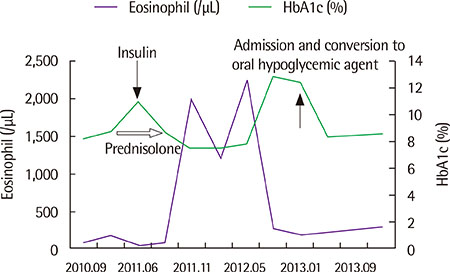Allergy Asthma Respir Dis.
2015 Jul;3(4):302-306. 10.4168/aard.2015.3.4.302.
Allergic reaction to recombinant human insulin
- Affiliations
-
- 1Department of Internal Medicine, Inje University Sanggye Paik Hospital, Inje University College of Medicine, Seoul, Korea. jmkim.benaiah@paik.ac.kr
- 2Department of Internal Medicine, Inje University Haeundae Paik Hospital, Inje University College of Medicine, Busan, Korea.
- KMID: 2218662
- DOI: http://doi.org/10.4168/aard.2015.3.4.302
Abstract
- Insulin-induced allergy is a rare adverse drug reaction since the introduction of recombinant human insulin. However, recombinant insulin-induced allergy is still being reported in 0.1% to 2% of all patients treated with insulin. This allergic reaction varies from mild localized skin reactions to life-threatening anaphylaxis. It has been shown that one-third of insulin allergy cases is related to insulin itself and the remaining occur due to preservatives contained in the insulin preparations, such as protamine, zinc, or metacresol. This case report describes a 75-year-old woman with poorly controlled diabetes who experienced insulin allergy. She complained of urticaria with itching after the injection of insulin. Allergic skin tests showed positive responses to all available human insulin preparations, and specific IgE to human insulin was also detected, which suggested that her urticaria was developed by insulin itself. This is the first case of insulin allergy that was sensitive to all available human insulin preparations and confirmed by the presence of specific IgE to human insulin. It is important to remember that allergic reactions to insulin may be directly associated with adherence and can be the reason of poor glucose control.
MeSH Terms
Figure
Reference
-
1. Pfohler C, Muller CS, Hasselmann DO, Tilgen W. Successful desensitization with human insulin in a patient with an insulin allergy and hypersensitivity to protamine: a case report. J Med Case Rep. 2008; 2:283.2. Hong JH, Lee JH, Shin JH, Kim DP, Ko BS, Kim BJ, et al. Maintenance of insulin therapy by desensitization in insulin allergy patient. Korean Diabetes J. 2008; 32:529–531.
Article3. Kim MH, Lim KH, Park HK, Kim BK, Kang MK, Kwon JW, et al. A case of change of insulin-specific antibodies following desensitization in insulin hypersensitivity patients. Korean J Asthma Allergy Clin Immunol. 2010; 30:63–67.4. Oh TK, Jung JI, Hahn Z, Kim MK. A case of human insulin allergy induced by rapid acting human recombinant insulin, humulin-R. Korean J Asthma Allergy Clin Immunol. 2006; 26:155–158.5. Castera V, Dutour-Meyer A, Koeppel M, Petitjean C, Darmon P. Systemic allergy to human insulin and its rapid and long acting analogs: successful treatment by continuous subcutaneous insulin lispro infusion. Diabetes Metab. 2005; 31:391–400.
Article6. Sohn I, Kim YY, Kang SY. Two cases of insulin allergy. J Asthma Allergy Clin Immunol. 1981; 1:126–130.7. Kim SY, Kim YY, Lee HK, Kang SY. A case of insulin allergy treated by desensitization. J Asthma Allergy Clin Immunol. 1982; 2:35–40.8. Lee AY, Chey WY, Choi J, Jeon JS. Insulin-induced drug eruptions and reliability of skin tests. Acta Derm Venereol. 2002; 82:114–117.
Article9. Adachi A, Fukunaga A, Horikawa T. A case of human insulin allergy induced by short-acting and intermediate-acting insulin but not by long-acting insulin. Int J Dermatol. 2004; 43:597–599.
Article10. Radermecker RP, Scheen AJ. Allergy reactions to insulin: effects of continuous subcutaneous insulin infusion and insulin analogues. Diabetes Metab Res Rev. 2007; 23:348–355.
Article11. Asai M, Yoshida M, Miura Y. Immunologic tolerance to intravenously injected insulin. N Engl J Med. 2006; 354:307–309.
Article12. Bodtger U, Wittrup M. A rational clinical approach to suspected insulin allergy: status after five years and 22 cases. Diabet Med. 2005; 22:102–106.
Article13. Ghazavi MK, Johnston GA. Insulin allergy. Clin Dermatol. 2011; 29:300–305.
Article14. Ben Ammar I, Ksouri H, Trabelsi N, Mellouli F, Ben Mami F, Dakhli S, et al. Generalized allergy due to zinc in insulin treated with zinc-free insulin. Acta Diabetol. 2012; 49:239–241.
Article15. Wheeler BJ, Taylor BJ. Successful management of allergy to the insulin excipient metacresol in a child with type 1 diabetes: a case report. J Med Case Rep. 2012; 6:263.
Article16. Clerx V, Van Den, Kochuyt A, Goossens A. Drug intolerance reaction to insulin therapy caused by metacresol. Contact Dermatitis. 2003; 48:162–163.
Article
- Full Text Links
- Actions
-
Cited
- CITED
-
- Close
- Share
- Similar articles
-
- Successful Desensitization of A Case of Anaphylaxis to Insulin
- A case of anaphylaxis to human recombinant insulin treated by desensitization
- Two Cases of Allergy to Insulin in Gestational Diabetes
- A Case of Human Insulin Allergy Induced by Rapid Acting Human Recombinant Insulin, Humulin-R
- The Transfer of Diabetic Patients from Animal Source Insulin to Human Insulin




